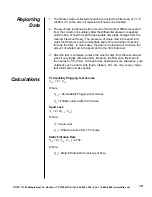
OFITE, 11302 Steeplecrest Dr., Houston, TX 77065 USA / Tel: 832-320-7300 / Fax: 713-880-9886 / www.ofite.com
16
Disassembly
1. Close the outlet ball valve by turning it 90° to the direction of flow. Close
the inlet valve stem by tightening it completely. This will seal the pressure
inside the cell.
2. Make sure the regulator on the CO
2
pressuring assembly is backed off
completely (counterclockwise). Release any remaining pressure by open-
ing the bleeder valve. Remove the CO
2
pressuring assembly from the
back pressure receiver.
3. Remove the back pressure receiver from the outlet valve assembly. Pour
any remaining filtrate into the graduated cylinder.
4. Release the pressure on the hydraulic pump by turning the release valve
on the pump counterclockwise until the pressure gauge reads 0 PSI (at
least four complete turns).
5. Remove the quick-connect from the inlet valve assembly. Leave the inlet
valve assembly connected to the cell.
6. Allow the cell to cool in the heating jacket.
The temperature of the sample in the cell must be less than 100° F
(46.5° C) before the cell can be safely opened.
7. Once the cell has cooled, remove it from the heating jacket.
8. Reconnect the pump to the inlet valve assembly. Make sure the pressure
release valve on the pump is open.
9. Slowly open the inlet valve stem one quarter turn. This will allow the
pressure in the cell to vent into the pump.
10. Hold the cell so that the inlet and outlet valves are pointing away from
people and equipment. Slowly open the outlet ball valve.
11. Remove the outlet valve assembly and cell cap.
12. Remove the ceramic disk and discard any remaining test fluid. Save the
ceramic disk for analysis. See page 18 for more information.
If the ceramic disk does not easily come out of the cell:
a. Close the pressure relief valve on the pump.
b. Stroke the pump until the pressure pushes the ceramic disk out of
the cell.
c. Then re-open the pressure relief valve on the pump.





































